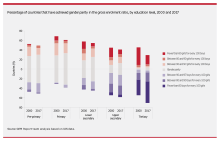Gender Parity Index
The Gender Parity Index (GPI) is a socioeconomic index usually designed to measure the relative access to education of males and females. This index is released by UNESCO. In its simplest form, it is calculated as the quotient of the number of females by the number of males enrolled in a given stage of education (primary, secondary, etc.). A GPI equal to one signifies equality between males and females. A GPI less than one is an indication that gender parity favors males while a GPI greater than one indicates gender parity that favors females.[1] The closer a GPI is to one, the closer a country is to achieving equality of access between males and females.[2] It is used by international organizations, particularly in measuring the progress of developing countries. The Institute for Statistics of UNESCO also uses a more general definition of GPI: for any development indicator one can define the GPI relative to this indicator by dividing its value for females by its value for males.[3] For example, some UNESCO documents consider gender parity in literacy.[4]

UNESCO describes attempts to eliminate gender disparities in primary and secondary education and emphasizes the plight of girls in unequal access in third world countries.[5] However, the GPI ignores the gender disparity that benefits first-world women in tertiary education. In Iceland, for example, 65% of students enrolling in tertiary education are female.
The World Economic Forum's Global Gender Gap Report 2016 allows users to look at and compare country GPI data, calculate your own country's gender parity, and explore global patterns.[6]
See also
Indices
- Bhutan GNH Index
- Broad measures of economic progress
- Disability-adjusted life year
- Full cost accounting
- Green national product
- Green gross domestic product (Green GDP)
- Gender-related Development Index
- Genuine Progress Indicator (GPI)
- Global Peace Index
- Gross National Happiness
- Gross National Well-being (GNW)
- Happiness economics
- Happy Planet Index (HPI)
- Human Development Index (HDI)
- ISEW (Index of sustainable economic welfare)
- Legatum Prosperity Index
- Leisure satisfaction
- Living planet index
- Millennium Development Goals (MDGs)
- Money-rich, time-poor
- OECD Better Life Index BLI
- Subjective life satisfaction
- Where-to-be-born Index
- Wikiprogress
- World Happiness Report (WHR)
- World Values Survey (WVS)
Other
- Economics
- Democracy Ranking
- Demographic economics
- Economic development
- Ethics of care
- Human Development and Capability Association
- Human Poverty Index
- Progress (history)
- Progressive utilization theory
- Post-materialism
- Psychometrics
- International Association for Feminist Economics
- International development
- Sustainable development
- System of National Accounts
- Welfare economics
- Gender Empowerment Measure
- Gender-related Development Index
- Gender equality
- Gender inequality
References
- "unstats | Millennium Indicators". unstats.un.org. Retrieved 23 February 2019.
- Baudot, Ana (10 February 2017). "IATE Term of the week: Gender Parity Index". Termcoord. Retrieved 23 February 2019.
- Koronkiewicz, Michael. "Gender Parity Index" (PDF). UNESCO Bangkok. Retrieved 26 November 2008.
- "Education for All (EFA) in least developed countries" (PDF). UNESCO. 2006. Retrieved 26 November 2008.
- Koronkiewicz, Michael. "Gender Parity Index" (PDF). UNESCO Bangkok. Retrieved 26 November 2008.
- "The Global Gender Gap Report 2016". World Economic Forum. Retrieved 23 February 2019.